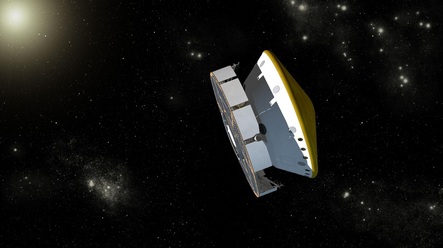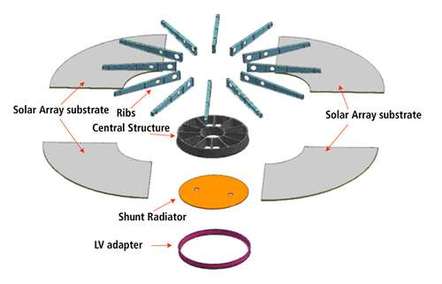MSL Cruise Stage

The cruise Stage carries the Rover through space until it arrives at Mars.
The cruise stage has a mass of about 400kg (880lbs). It is comprised of a central aluminum machined structure including support ribs, solar arrays, a radiator and the Payload Adapter that connects it to the Launch Vehicle and provides data and electrical interfaces. Two titanium tanks hold Hydrazine that is used to power 8 Thrusters that are used for trajectory corrections and attitude control. The solar array and a battery will provide a continuos power source for the vehicle.
During launch, the Cruise Stage will communicate with the launch vehicle and the ground. The Stage will be spinning at about two revolutions per minute to maintain stability and forward momentum. 6 TCMs (Trajectory Control Maneuvers) are planned to occur during the cruise phase of the mission to ensure the vehicle is targeting the correct landing area on Mars. Two X-Band Antennas are used for communication with NASA’s Deep Space Network.

The primary Communications Asset of the Cruise Stage is a Medium Gain Antenna. Data feeds from the rover are sent to the Cruise Stage which then relays the feed to Earth keeping mission controllers up to date on all aspects of vehicle health. The Cruise Stage is essential for keeping the Rover in a thermally controlled environment during the long cruise phase. Liquid Cooling systems circulate fluids through pumps and radiators as part of the Heat Rejection System that dissipates heat that is generated by power sources and motors into space.
The other part of the Thermal System consists of passive thermal protection (e.g. blankets) to keep sensitive instruments warmer since those components can’t be exposed to the temperatures that are experienced during the cruise (near-absolute zero). Thermostats will monitor thermal conditions and activate/deactivate the equipment that is used to regulate temperatures. Navigation is provided by a star tracker. When arriving at Mars, a cable cutter separates the cruise stage at the proper pre-programmed time from the aeroshell that will protect MSL from the Entry Environment. The Cruise Stage’s job is done at that point in the mission.
